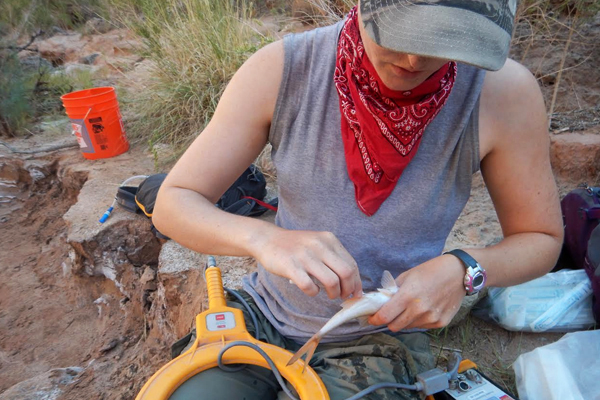Detecting Fish Parasites in Humpback Chub
 The Grand Canyon. (Credit: Meredith Campbell / New Mexico State University)
The Grand Canyon. (Credit: Meredith Campbell / New Mexico State University)The Asian tapeworm, or Schyzocotyle acheilognathi, is a fish parasite that originated in China and Eastern Russia. The parasite likely migrated in the early 1900s and spread throughout American waterways as unknowingly infected fish were used as bait and subsequently spread the disease.
According to the Food Safety Authority of Ireland, there are three types of fish parasites, roundworms, flatworms or flukes and tapeworms. The Asian tapeworm is part of the cestode family and thrives in warmer, freshwater environments. Unfortunately, the parasite’s ideal environment places it in direct proximity to important aquatic life.
The Asian tapeworm infects many fish species, but researchers are particularly concerned with the parasite’s impact on endangered species like the humpback chub. Infected fish generally have a reduced capacity to handle stressors within an environment, according to the United States Geological Survey.
Food insecurity is one stressor that often leads the host fish to become sick and die. Juvenile fish most heavily feel the impacts. Common symptoms are poorer overall health, reduced physical development, and temperature-dependent mortality. Asian tapeworms lead fish to have lower survival rates and have harmed conservation efforts as national and local groups work to protect endangered species.
Managing the Asian Tapeworm
Hatchery managers try to manage the invasive fish parasite with drugs similar to those used to de-worm dogs. Another part of managing the parasite is detection, something that isn’t done easily.
The old-school method of examining fish potentially infected by the parasite involved killing the suspect fish. When working with an endangered species, every creature matters. Humpback chub can only be found in the Colorado River watershed, with the largest remaining population surviving in Little Colorado River and the Colorado River within the Grand Canyon. All this is to say that the traditional method of testing for Asian tapeworms is not ideal.
Safe Testing Methods
In an ongoing study searching for a new, non-lethal way to test endangered fish such as the humpback chub for the invasive Asian tapeworm, researchers from the U.S. Fish and Wildlife Service and New Mexico State University have made seasonal research trips to the Grand Canyon. While there, the scientists sampled hundreds of fish and tested out a possible replacement for the lethal screening procedure.
“Fish health inspections for Asian tapeworm or other gastrointestinal parasites generally involve necropsy and/or microscopy to visualize and identify parasites in the fish intestine, and this method is not ideal for an endangered fish. The detection method I’m working on is non-lethal,” said Meredith Campbell, a graduate research assistant at New Mexico State University. “If we can screen wild fish with the non-lethal methodology, then we can get an estimate of prevalence in the wild as part of assessing the overall health of this fish population. Right now, it’s simply not an option to be doing screening and treatment of these wild fish because they are protected.”
The method that Campbell is working to develop doesn’t involve hurting fish at all. Instead, it utilizes unique genetic primers made to help detect infection of the parasite. She is combining that with anogenital swabs that pick up fecal matter. The reasoning is sound: Since Asian tapeworm infections are transmitted through feces, it makes sense to look there.

Meredith Campbell completes an anogenital swab of a humpback chub. (Credit: Meredith Campbell / New Mexico State University)
Researching Future Practices
If the new method pans out, others involved with the project say that it could also aid in working to prevent the extinction of endangered humpback chub. That’s partly because it’s unclear how much the fish is being affected by Asian tapeworm in the environment. The effects are also murky because the fish didn’t evolve with the parasite as the tapeworm is not native to North America.
“As a federally endangered fish, humpback chub already face a number of threats and challenges, including extreme habitat modification, invasive competitors and predators (such as brown trout and catfish) and introduced parasites and diseases. Depending on the severity and intensity of infection, Asian tapeworm can cause pathology like blockage of the gut, gastrointestinal inflammation, hemorrhaging and perforation,” said Campbell. “Asian tapeworm has the potential to affect the growth and survival of fish that could potentially be recruited into the population, especially vulnerable juvenile fish. Essentially, Asian tapeworm is one more complication in a long list of factors contributing to the plight of the humpback chub.”
So to further the goal of building a new, non-lethal detection method, Campbell traveled with the U.S. Fish and Wildlife Service to the Grand Canyon in April and September 2015 to gather and swab as many fish as possible.
Methods
While there, she followed U.S. Fish and Wildlife protocols to gather data.
“For capturing fish, we deployed hoop nets, which are nets with a cone-shaped mouth to allow fish to enter but not escape. These nets are placed along the edge of the river or below the travertine dams where the fish tend to aggregate and spawn,” said Campbell. “I used these sampling trips as an opportunity to collect data for my study, which included collecting fecal swabs for genetic analysis and confirmation of Asian tapeworm infection.”
She and others also recorded information on individual humpback chub captured, such as size, condition and PIT (passive integrated transponder) tag numbers. With that data, it is possible to then correlate Asian tapeworm infections with variables like fish age, capture location and condition.
Spotting Asian Tapeworms in Other Species
“I am optimistic that the work will shed some light on the prevalence of Asian tapeworm in this population of humpback chub. I also think the tool has potential utility for managers of captive stocks of humpback chub to quickly and easily screen fish before translocation,” said Campbell. “Ultimately, the goal of the tool is to provide the option for managers of these fish to incorporate screening for internal parasites into their routine population monitoring and health assessments.”
Campbell’s work was published in 2019, and the data proved that her nonlethal method worked as a means of testing fish for parasitic infections. This work will help humpback chub and other endangered species that suffer from fish parasites.


0 comments